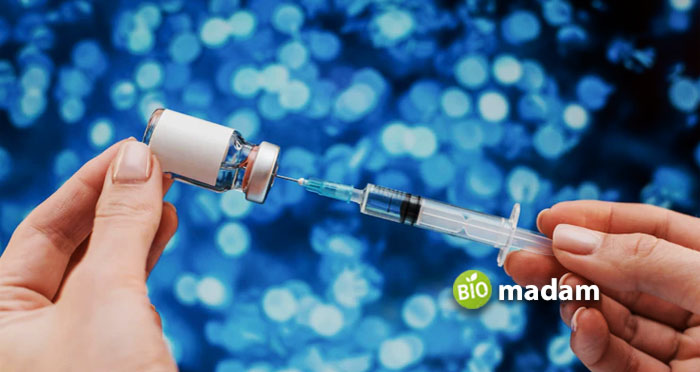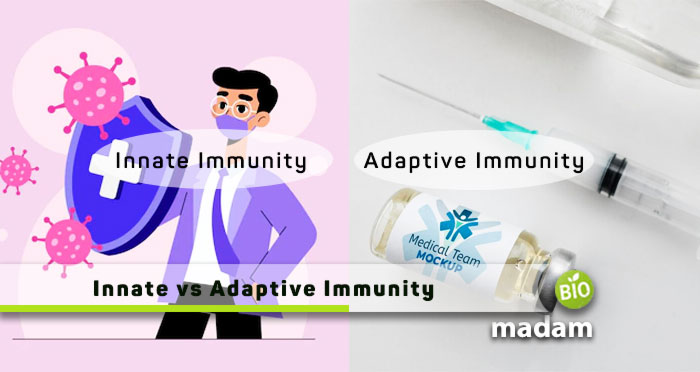Several microorganisms enter your body every day, but you do not get sick. Do you know why?
Because of the immune system.
The immune system is an essential part of the body that protects you against diseases and infections. It is composed of different tissues and cells. They work together to fight against disease-causing microorganisms. However, each immune system component does not perform exactly the same function. Every part has a specific function like other body organs and systems. Let’s tell you all the differences between innate and adaptive immunity for easy understanding.
Comparison Table
| Characteristic | Innate Immunity | Adaptive Immunity |
| Specificity | Non-specific | Specific |
| Defense Order | First line of defense | Third line of defense |
| Presence | At birth | Acquired later |
| Inducibility | No | Yes |
| Response Time | Immediate | 4-7 days or more |
| Response Type | Limited | High potency |
| Functional Against | Microbes | Microbial or nonmicrobial antigens |
| Involved Cells | NKCs, macrophages, dendritic cells, eosinophils | B & T cells, and APCs |
| Memory | No | Yes |
| Complement System Activation | Alternative pathway | Classical pathway |
| Barriers | Skin, stomach acid, mucous membrane | Lymph nodes, spleen |
| Hypersensitivity Reaction | No | Yes |
| Development | Since the beginning | Recently developed |
| Examples | Infection or wound | Vaccination |
What is Innate Immunity?
Innate immunity refers to a built-in fight mechanism that saves your body from pathogens. It is present in the body since an individual’s birth and stays till death. Unlike adaptive immunity, you do not need prior exposure to the antigen or a pathogen. Innate immunity works as the first line of defense to keep you safe. It fights harmful microbes through external and internal defense.
External defense includes physical and chemical barriers like skin, sweat, tears, etc. On the other hand, stomach acids, mucous lining, and good bacteria in the gut internally save you from diseases. Every individual has innate immunity. It could vary in different individuals, and some might have a better immune system than others. Neutrophils, monocytes, dendritic cells, and mast cells form innate immunity. Meanwhile, macrophages prevent the growth of microbes inside the body by engulfing them.

What is Adaptive Immunity?
Adaptive immunity is one adapted through external means besides innate. It is also known as the body’s third line of defense or acquired immunity. It is mediated by the B and T cells of the immune system. Adaptive immunity works through a recognition system. The body creates a memory to generate an appropriate response the next time.
Adaptive immunity is categorized into two types; cell-mediated and humoral immunity. Cell-mediated immunity develops by the killer t cells that kill the pathogen. Conversely, helper T cells signal B lymphocytes to produce antibodies. Humoral immunity develops due to the production of antibodies against a particular antigen. While adaptive immunity works to kill harmful pathogens, sometimes it may attack the body’s cells. This results in autoimmune disorders. Adaptive immunity does not offer a quick response like innate immunity. Yet the effect is long-lasting.

Similarities between Innate and Adaptive Immunity
- They both are part of the immune system and are composed of body organs, tissues, and cells.
- Innate and adaptive immunity work to protect your body from bacteria and viruses.
- They cannot kill all pathogens, which sometimes makes us sick.
Differences between Innate and Adaptive Immunity
Definition
Innate Immunity
Innate immunity is present in the body since birth and acts on the antigen immediately.
Adaptive Immunity
Adaptive immunity is not present since birth and gives long-lasting protection.
Specificity
Innate Immunity
Innate immunity does not act on any specific antigen and is also known as non-specific immunity.
Adaptive Immunity
Adaptive immunity acts on a specific antigen that interacted previously, so it is specific immunity, instead of non-specific.
Defense Order
Innate Immunity
Innate immunity is known as the first line of defense as it tries to keep pathogens from entering the body.
Adaptive Immunity
Adaptive immunity is called the third line of action of the immune system.
Presence at Birth
Innate Immunity
Innate immunity is present in your body naturally at the time of birth.
Adaptive Immunity
Adaptive immunity is not present since birth. It is acquired over time.
Inducibility
Innate Immunity
Innate immunity is a part of the body since you are born. It is not induced by external means.
Adaptive Immunity
Adaptive immunity is acquired or induced through external means such as vaccines and antibiotics.
Response Time
Innate Immunity
Innate immunity responds to any foreign invader immediately.
Adaptive Immunity
Adaptive immunity may take around 4 to 7 days or a week to develop before fighting antigens.
Response Type
Innate Immunity
Innate immunity produces a quick yet low potency and limited response.
Adaptive Immunity
Adaptive immunity produces a more potent response that helps fight a specific microbe swiftly.
Functional Against
Innate Immunity
Innate immunity is typically functional against general microbes, including bacteria, archaea, fungi, molds, tissue injury, burns, etc.
Adaptive Immunity
Adaptive immunity acts on microbial as well as nonmicrobial substances called antigens.
Involved Cells
Innate Immunity
The cells involved in innate immunity are natural killer cells, macrophages, dendritic cells, eosinophils, etc.
Adaptive Immunity
Adaptive immunity functions through the combined action of antigen-presenting cells, B cells, and T cells.
Memory
Innate Immunity
Innate immunity does not have a memory and may not respond to a pathogen in the same way as the previous time.
Adaptive Immunity
Adaptive immunity develops memory and reacts the same way on later interactions with the antigen.
Complement System Activation
Innate Immunity
Innate immunity activates the system through lectin and the alternative pathway.
Adaptive Immunity
Adaptive immunity activates the complement system through the classical pathway.
Barriers
Innate Immunity
The skin, mucous membrane, stomach acid, and body chemicals act as the first line of defense besides macrophages and other immune cells.
Adaptive Immunity
Lymph nodes, mucosal-associated lymphoid tissues, and spleen contribute to adaptive immunity or the third line of defense.
Hypersensitivity
Innate Immunity
The presence of innate immunity is accustomed to your body’s needs and does not cause any reactions.
Adaptive Immunity
Acquiring adaptive immunity may cause a rapid or delayed hypersensitivity reaction.
Development
Innate Immunity
It has been present in all animals, including vertebrates and invertebrates.
Adaptive Immunity
Adaptive immunity is comparatively new and only found in vertebrates, especially humans.
Examples
Innate Immunity
Innate immunity is the body’s natural response to fighting microbes like white blood cells fighting a microbe or wound formation.
Adaptive Immunity
Adaptive immunity is acquired through vaccines like vaccination for polio or measles and mumps.
The Bottom Line
Innate and adaptive immunity performs particular functions in keeping the body protected from foreign invaders. Innate immunity is present in the body since birth, whereas adaptive immunity is acquired through external factors. The former provides an immediate response, while the latter takes a week to initiate the reaction. Adaptive immunity was developed a few decades back to save people from diseases.

Anna has completed her degree in Pharmacy from the University of Hawaii. She is serving as a research assistant in a pharmaceutical company. She had a great interest in writing blogs, traveling to different parts of the US, and trying delicious recipes in her spare time.

